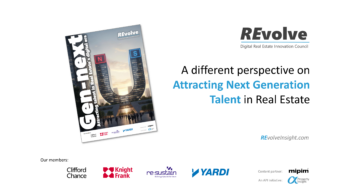Perhaps more than any other cities, European city centers are faced with a delicate balancing act—respecting and preserving their historic heritage while adapting to the ever-changing needs of their residents. In other words, how to resist becoming “museum cities”. It was fitting, then, that Kai Uwe Bergmann opened MIPIM’s PropTech conference (held in a reimagined historic building in the city’s dynamic 19th arrondissement), by showcasing different ways that BIG, the Bjarke Ingels Group, is integrating technology into five new or redevelopment projects for French cities.
“I think there’s nothing more sustainable than actually maintaining and keeping the heritage that is around us, and then also finding ways to integrate the technology that we use every single day into these historical structures”, Bergmann said to a packed auditorium.
From Bordeaux, where BIG designed a cultural center along the waterfront—“it’s really imagined as kind of an urban room within the city, so that the promenade along the water actually wraps up into the building and then brings you out into the city”, he explained—to Paris, where the firm redesigned a metro station to bring sunlight deep underground, BIG is interested in holistic design.
“By that I mean it’s not only architecture to us”, Bergmann said, “it’s also about the site, and in this case, the landscape. So BIG is landscape, BIG is engineering, BIG is architecture, and BIG is products”.
Part of the way that technology can help holistic design is by providing data about a future worksite—bus routes, bicycle routes, traffic connections, location of green spaces and how much green space is available in the broader urban area… In a Q&A session with Terra Incognita, Bergmann pointed out that this plethora of data is indispensable when designing with climate sustainability in mind.
“I think there is an imperative to actually deal with creating spaces thinking about the urban heat island effects, thinking about the kind of decisions that we’ve been making up to this point that have caused the current state of things”, he said. For Bergmann, Singapore is a model; the city has required for decades that buildings maintain a certain portion of green roofing. “By doing green roofs on every urban property, what happens is that rain water is kept and maintained. Then, you use evaporative cooling and the same sun that was hitting dark spaces and heating up roofs and heating up the asphalt in the streets…Singapore has actually been able to drop its temperature by a couple of degrees Celsius”.
Combatting urban heat island effects has economic value beyond the quality of life improvements it provides—lowering temperatures through natural, passive means equates with potentially enormous monetary and energy savings through less need for air conditioning.
Bergmann also detailed two data intensive projects involving adapting cities to the consequences of climate change. One is a protective flood management system for New York City. “That is entirely based on modelling of what future scenarios are”, he said. “Is it a one-and-a-half foot, three-foot, six-foot sea level rise?”
The second is a “floating cities” project spearheaded by the United Nations. Rising sea levels doesn’t just mean flooding, it means a global climate refugee crisis affecting millions of people. “So the UN is looking for ways to not only capture tens of thousands of people [at a time]but in terms also of making sure that they live somewhere close to the very places that they have to leave, so we are developing and conceiving of this floating city as a prototype”. As Bergmann explains, it’s about more than just architecture and design. “You start with the caloric consumption of a single human being, because you need to then ensure that the floating city can actually produce the fuel that a person needs in order to exist, because you don’t want to create a floating city that is dependent on things that are too far away, or too costly to burn…”
For Bergmann and BIG, ultimately holistic design is a way of thinking that integrates heritage and technology in order to meet future challenges. It’s about, as Bergmann concluded, “not only thinking about our history but really creating a future history in which we learn from the past”.



